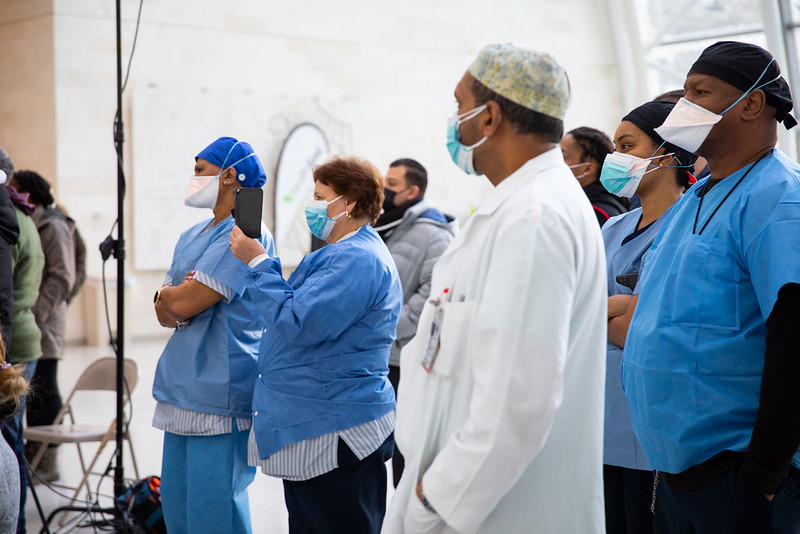History Demonstrates That Diversity Is the Future of Medicine

[ad_1]

Health care workers on the front lines (photo: Michael Appleton/Mayoral Photography Office)
As we celebrate Black History Month, I often reminisce on the saying, “If I have seen further, it is by standing on the shoulders of giants.” As a cardiologist, Vivien Thomas is one of the many African-American giants whose shoulders I’m privileged to stand on. To me, he is a pillar of cardiac surgery, a master anatomist, an exemplary scientist, and a selfless servant to others.
Mr. Thomas (please note the lack of title to his name, an issue I will touch upon below) was a laboratory supervisor who developed the first procedure in the 1940s to treat “blue baby syndrome,” a heart condition that can cause the skin of babies to turn blue because of a lack of oxygen in their blood. Before his contribution, heart disease was a death sentence for those babies. Vivien Thomas holds a special place in my heart as an alumnus of my alma mater, John Hopkins University School of Medicine, where his portrait hangs today.
He served as an assistant surgeon, and what makes his story even more remarkable is that he accomplished this without a professional medical education. He was paid and classified as a janitor while helping develop this life-saving procedure. It wasn’t until late in his career that the university awarded him the honorary title of Doctor.
Imagine if, for a moment, he had the formal training and resources to be a doctor, what the ramifications could have been not only for the field of medicine but his community. Studies have shown that diversity and representation in medicine matter immensely. Representation of doctors and nurses of color helps inspire the next generation of healthcare professionals. It also helps to rebuild trust between patients and their healthcare system and has been shown to improve clinical outcomes.
Even 80 years after Mr. (Dr.) Thomas’ groundbreaking contributions to infant health and cardiology, serious racial discrepancies still exist in medicine. To date, African-Americans make up less than 3% of doctors in the U.S, and in my specialty of cardiology, less than 1%. This statistic should cause alarm for communities across the country, whether urban, suburban, or rural. We have a growing diverse population, and the doctors charged with tending to it may not understand cultural or racial nuisance or they might present subconscious or implicit bias when providing care.
Two studies from the New England Journal of Medicine show that African-American patients suffering from heart disease are less likely than white patients to receive invasive heart procedures such as cardiac catheterization, even when everything else between the groups is equal. Furthermore, the bias toward Black patients (whether explicit or implicit) persisted even when the treating physicians were Black.
“Factors associated with a difference in race between physicians and patients, such as cross-cultural miscommunication, 11,12 lack of rapport or trust, 13,14 and reduced willingness on the part of the patient to undergo an intervention, 15 may lead to the use of fewer medically-necessary procedures among Black patients,” according to the study authors.
And a new study from researchers at the University of Chicago found that implicit bias in the medical field extends beyond the examination room and into the electronic health record (EHR). Black patients were 2.5 times more likely than white patients to have at least one negative term in their EHR.
Even knowing the numbers and understanding the effects, our nation’s medical field has yet to properly address the needs at hand. Studies have shown that African-Americans are more likely to suffer from heart-related conditions like high blood pressure, diabetes, and stroke. To combat these negative health outcomes, we need more doctors who can relate to patients and give them health guidance and strategies to manage their unique journeys in a culturally appropriate manner.
As an ever-diversifying country, we need to develop an achievable and sustainable plan to better recruit and retain minority physicians in all specialties. New York City alone is — to borrow from former Mayor David Dinkins — “a gorgeous mosaic of race and religious faith, of national origin and sexual orientation.” As of the last Census, minority groups make up over two-thirds of the city’s population. Still, less than 3% of doctors nationwide are people of color, and less than 1% of cardiologists are African-American.
At AdvantageCare Physicians, where I practice, we pride ourselves on having diverse, culturally competent medical professionals who identify with or come from the communities where they provide care. Yet our field as a whole still has much more work to do in New York City and throughout the country.
The face of the nation is changing. Our national population grew by over 7% since 2010, according to results from the 2020 U.S. Census. These changes mean that our approach to every facet of life, including providing proper health care, needs to evolve. The next great minds to help address this challenge are out there. We need to find, nurture, and grow them to be ready to join us.
Over the last century, countless institutions throughout our country have contributed ground-breaking work in the fields of cardiology and medicine, including the life-saving surgeries for “blue babies” at Johns Hopkins. However, we mustn’t forget the example that this work was pioneered by an outsider with an untraditional background, who faced insurmountable odds to save lives. As we reflect on Black History and on Dr. Thomas’ accomplishments, we must also contemplate how to move further with his legacy. We can start by attracting other brilliant minds from our diverse communities to help move healthcare into the future.
***
Dr. Haitham Ahmed, MD, is Chair of Cardiology at AdvantageCare Physicians, one of the largest primary and specialty care practices in the New York area.
***
Have an op-ed idea or submission for Gotham Gazette? Email This email address is being protected from spambots. You need JavaScript enabled to view it.
[ad_2]
Source link
